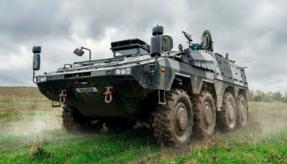
X-ray backscatter imaging is increasingly used in combat zones to identify the presence of explosives and weapons. However, advanced systems enabled by artificial intelligence and robotics are now opening the door to more sophisticated applications.

Chris Froud
In the past, UAVs or drones with sensors and detectors on board have been used to survey large areas of land. These drones search for visible signs that could indicate the presence of unexploded devices, such as landmines or improvised explosive devices (IEDs). As they don’t disturb the ground and can be operated remotely, they represent a safe solution to an innately hazardous activity.
In some circumstances however, it may not be possible to deploy drones due to their long range view. The close-up examination of a specific area might be required to get a clearer idea of any hazards that might be present. In these situations, x-ray backscatter (XRBS) imaging techniques can be deployed on the ground to see through walls and into containers, such as cars or lorries, to find out what’s inside. The latest detection systems can identify unexploded devices in a confined space which may be hidden from view, with a high degree of accuracy and reliability.
At the end of last year, the Defence Science and Technology Laboratory confirmed that it had successfully completed field trials on a Rapiscan American Science and Engineering (Rapiscan ASE) produced prototype that uses XRBS imaging technology set on a L3 Harris T7 remote-controlled robot. Those responsible for the trials claim that whilst XRBS imaging technology is established technology, its application in the field of unexploded ordnance detection is new and will help to save lives.
XRBS imaging technology uses low-energy x-rays to create images of objects being scanned. It is perhaps best known as a technology used for scanning passengers and luggage at airports in the aftermath of 9/11. The technology later fell out of favour due to concerns about the use of x-rays and their potential health effects. However, it remains well suited to niche, defence sector applications.
Recent advances in XRBS imaging technology, achieved through data augmentation and image-to-image translation methods, have helped to improve pattern detection and the quality of the translated images received by the operative. Data augmentation is typically used to overcome a lack of training data when building AI systems. When applied to the detection of unexploded ordnance (UXO), these advancements can have a significant impact on outcomes. For example, patented technology developed by Rapiscan ASE uses AI models to validate cargo contents by matching live image data to a vast volume of third-party descriptive data. The system is able to detect the presence of drugs and explosives.
From an intellectual property perspective, many patents already exist for XRBS imaging technologies and many also exist for remote-controlled robotic systems. However, this prior art shouldn’t put off tech-led companies from exploring the patentability of novel solutions using existing technology to target new applications. For example, hand-held x-ray backscattering systems have secured patent protection for airport security applications.
In the case of the new prototype, two established technologies – remote-controlled robots and XRBS imaging – have been combined and their capabilities augmented through the power of AI, to save lives on the battlefield and in other hazardous situations. However, there could be other commercial applications too. With this in mind, innovators should seek specialist IP advice before disclosing details of any invention that could represent a technological step forward.
Chris Froud is a partner and specialist in the field of robotics and automated systems at European intellectual property firm, Withers & Rogers.
If you would like to join our community and read more articles like this then please click here








